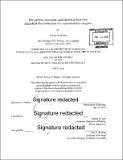The genetic, neuronal, and chemical basis for microbial discrimination in Caenorhabditis elegans
Author(s)
Meisel, Joshua D. (Joshua Daniel)
DownloadFull printable version (12.53Mb)
Other Contributors
Massachusetts Institute of Technology. Department of Biology.
Advisor
Dennis H. Kim.
Terms of use
Metadata
Show full item recordAbstract
Discrimination among pathogenic and beneficial microbes is essential for host organism immunity and homeostasis. Increasingly, the nervous system of animals is being recognized as an important site of bacterial recognition, but the molecular mechanisms underlying this process remain unclear. Chapter One discusses how the nematode Caenorhabditis elegans can be used to dissect the genetic and neuronal mechanisms that coordinate behavioral responses to bacteria. In Chapter Two, we show that chemosensory detection of two secondary metabolites produced by Pseudomonas aeruginosa modulates a neuroendocrine signaling pathway that promotes C. elegans avoidance behavior. Specifically, secondary metabolites phenazine- I -carboxamide and pyochelin activate a G protein-signaling pathway in the ASJ chemosensory neuron pair that induces expression of the neuromodulator DAF-7/TGF-[beta]. DAF-7, in turn, activates a canonical TGF-P signaling pathway in adjacent interneurons to modulate aerotaxis behavior and promote avoidance of pathogenic P. aeruginosa. This chapter provides a chemical, genetic, and neuronal basis for how the behavior and physiology of a simple animal host can be modified by the microbial environment, and suggests that secondary metabolites produced by microbes may provide environmental cues that contribute to pathogen recognition and host survival. Genetic dissection of neuronal responses to bacteria in C. elegans can also lend insights into neurobiology more generally. In Chapter Three we show that loss of the lithium-sensitive phosphatase bisphosphate 3'-nucleotidase (BPNT-1) results in the selective dysfunction of the ASJ chemosensory neurons. As a result, BPNT- 1 mutants are defective in behaviors dependent on the ASJ neurons, such as pathogen avoidance and dauer exit. Acute treatment with lithium also causes reversible dysfunction of the ASJ neurons, and we show that this effect is mediated specifically through inhibition of BPNT-1. Finally, we show that lithium's selective effect on the nervous system is due in part to the limited expression of the cytosolic sulfotransferase SSU-1 in the ASJ neuron pair. Our data suggest that lithium, through inhibition of BPNT- 1 in the nervous system, can cause selective toxicity to specific neurons, resulting in corresponding effects on behavior of C. elegans. In Chapter Four I discuss the future directions for the genetic dissection of pathogen recognition in C. elegans.
Description
Thesis: Ph. D., Massachusetts Institute of Technology, Department of Biology, 2016. Cataloged from PDF version of thesis. Includes bibliographical references.
Date issued
2016Department
Massachusetts Institute of Technology. Department of BiologyPublisher
Massachusetts Institute of Technology
Keywords
Biology.